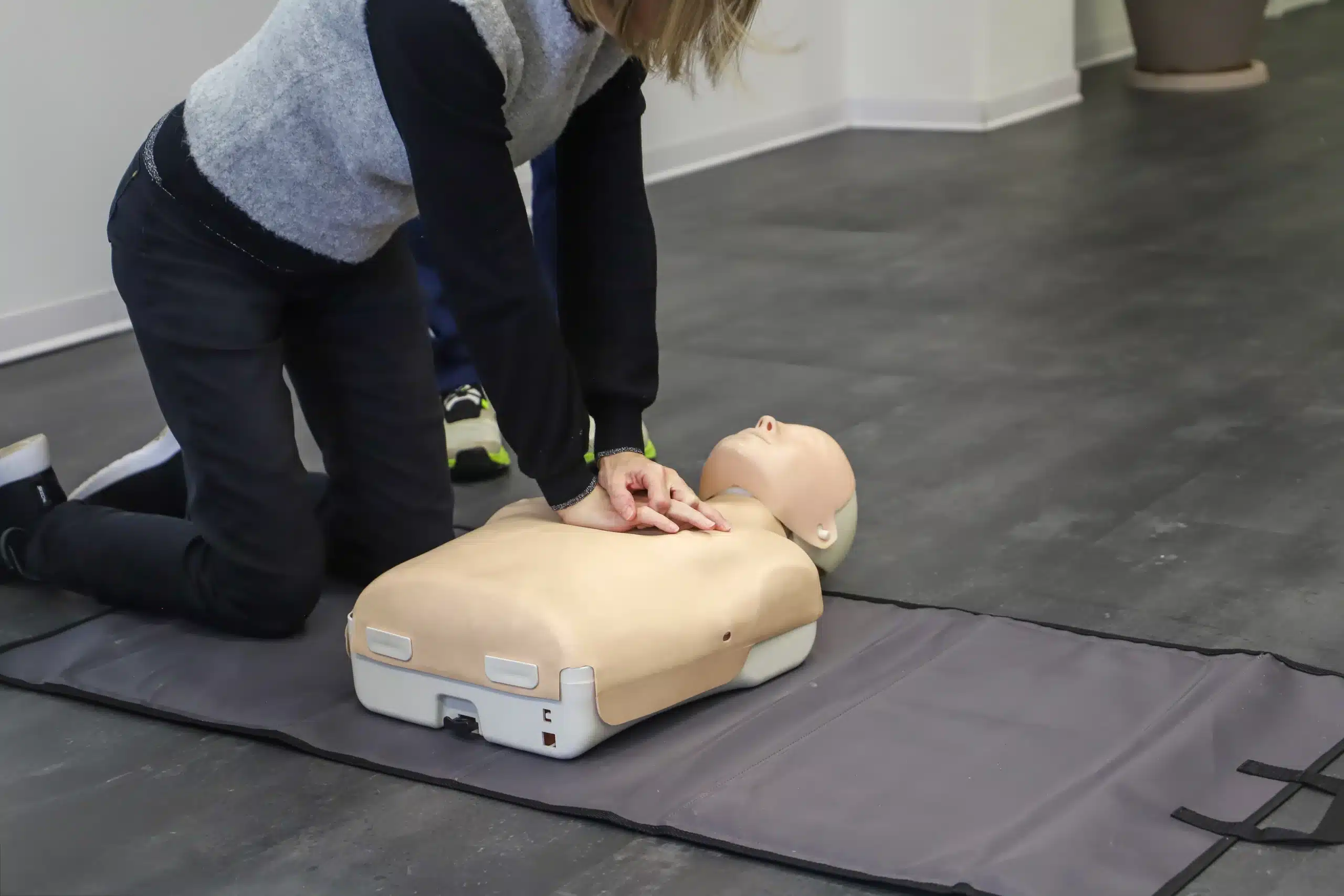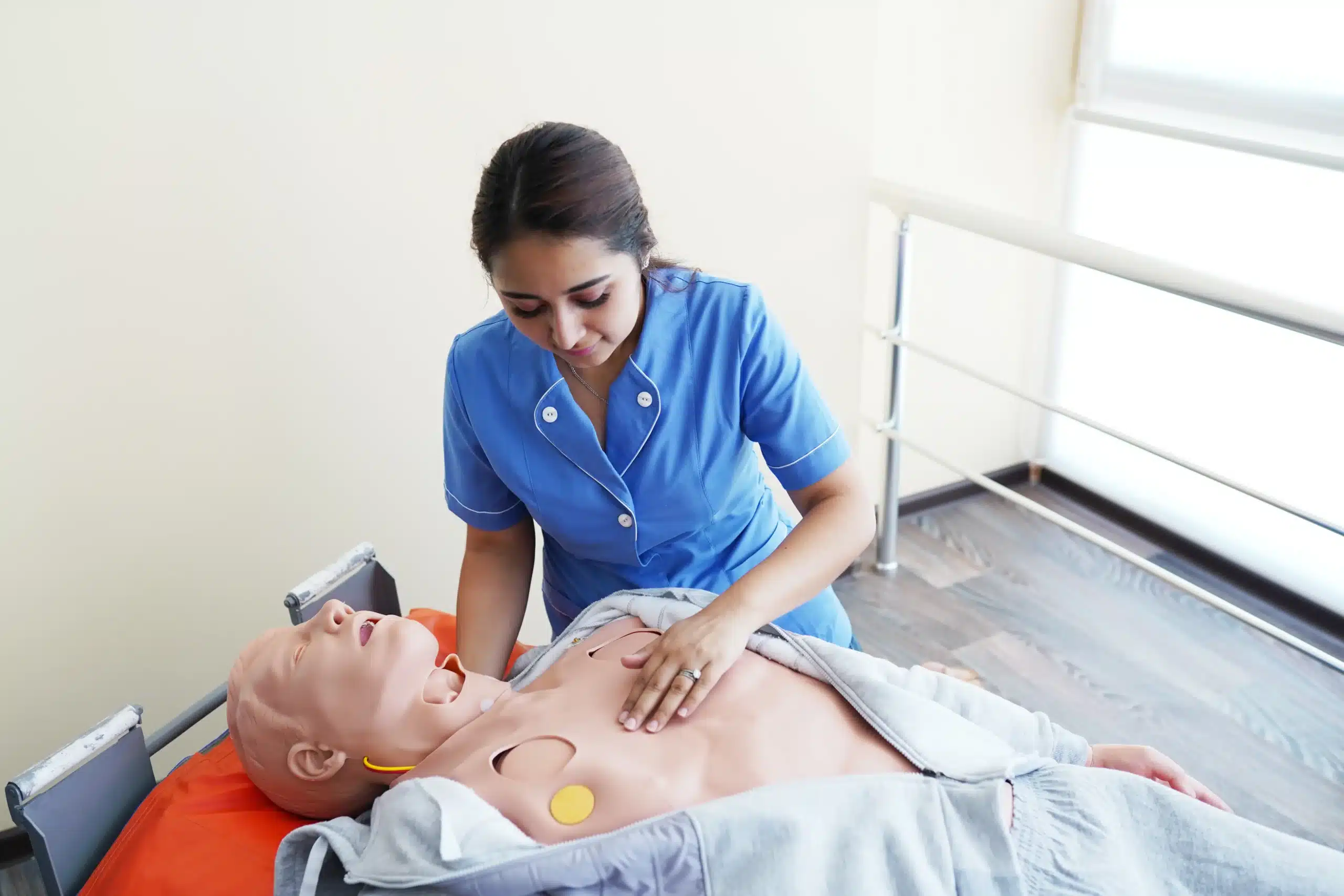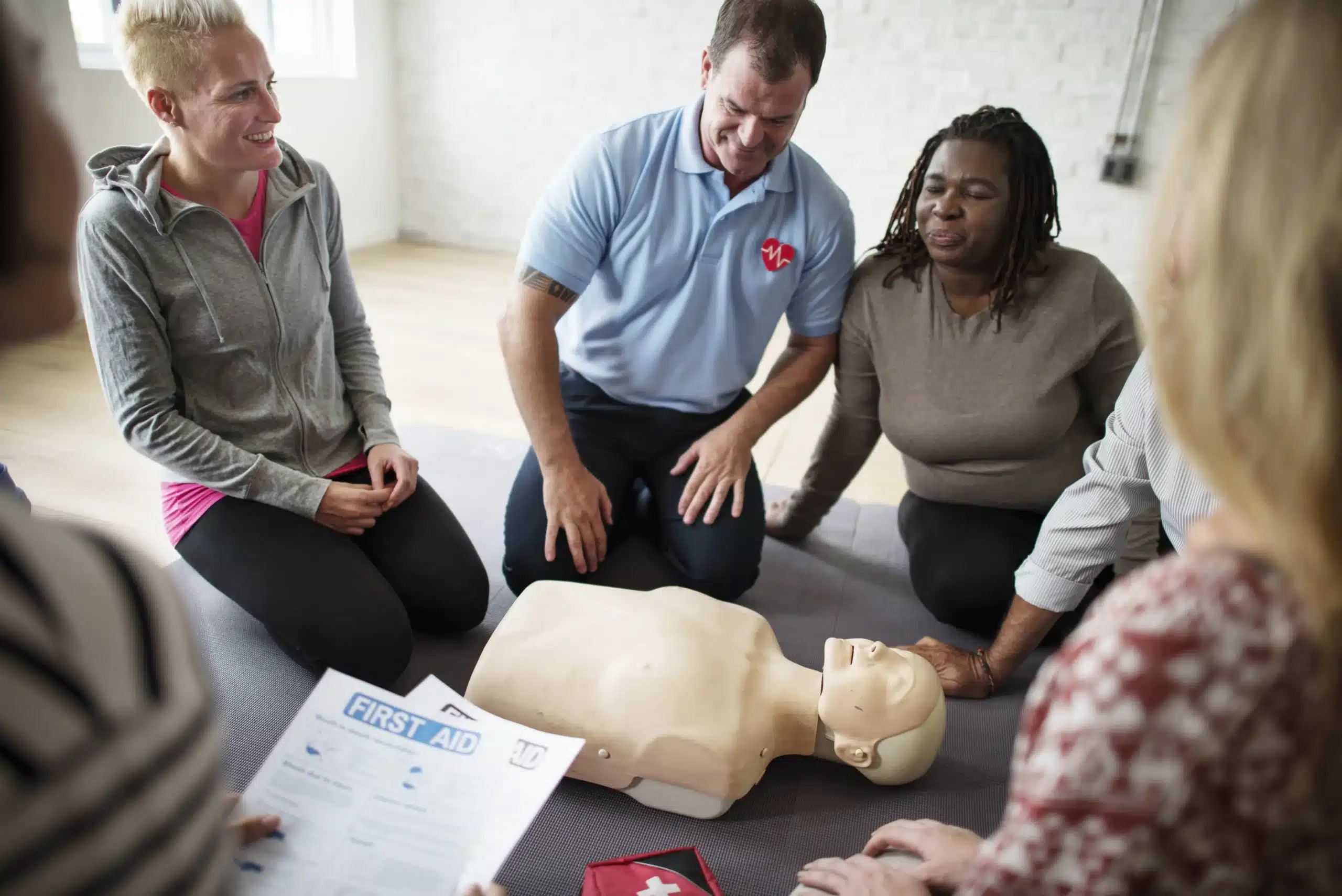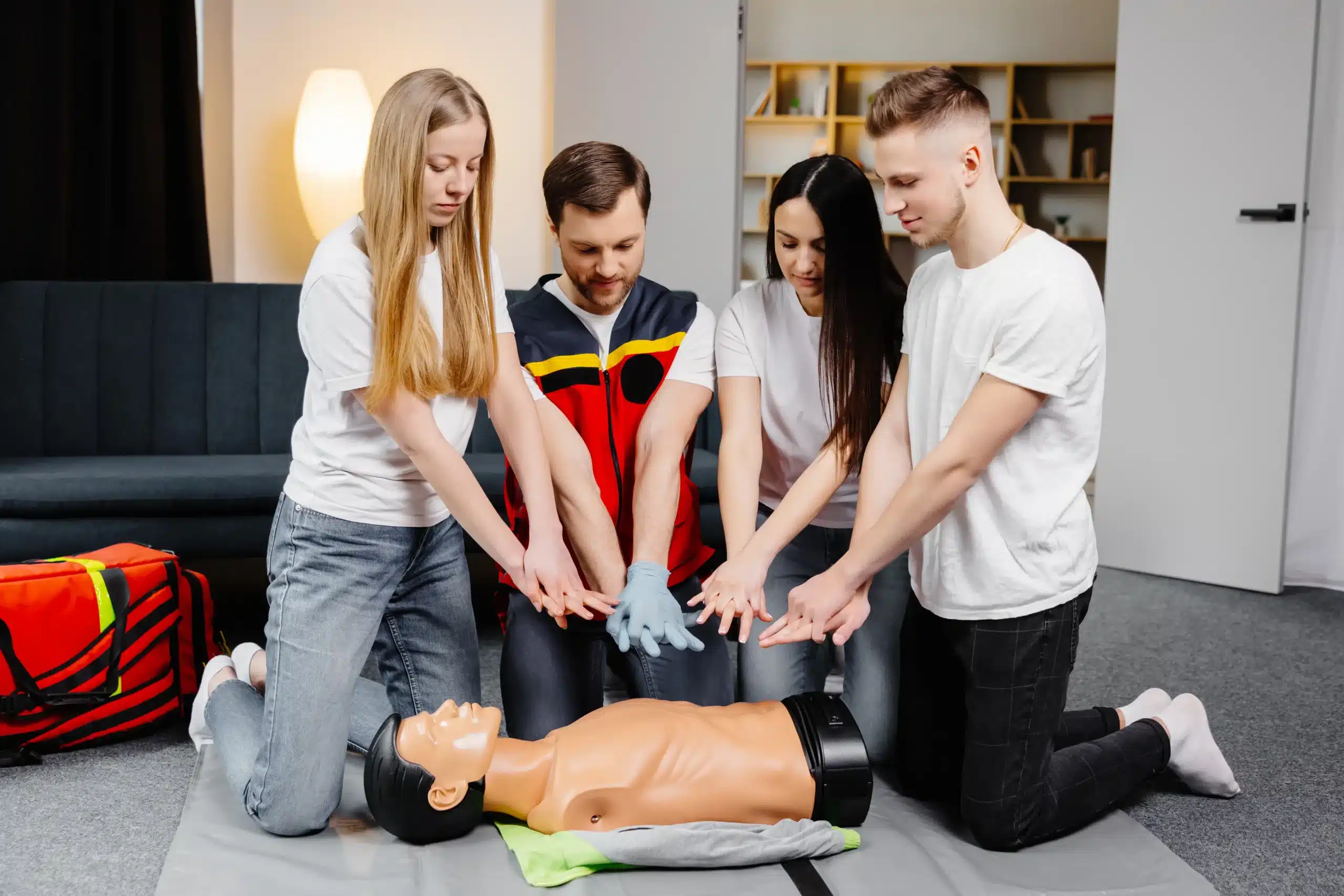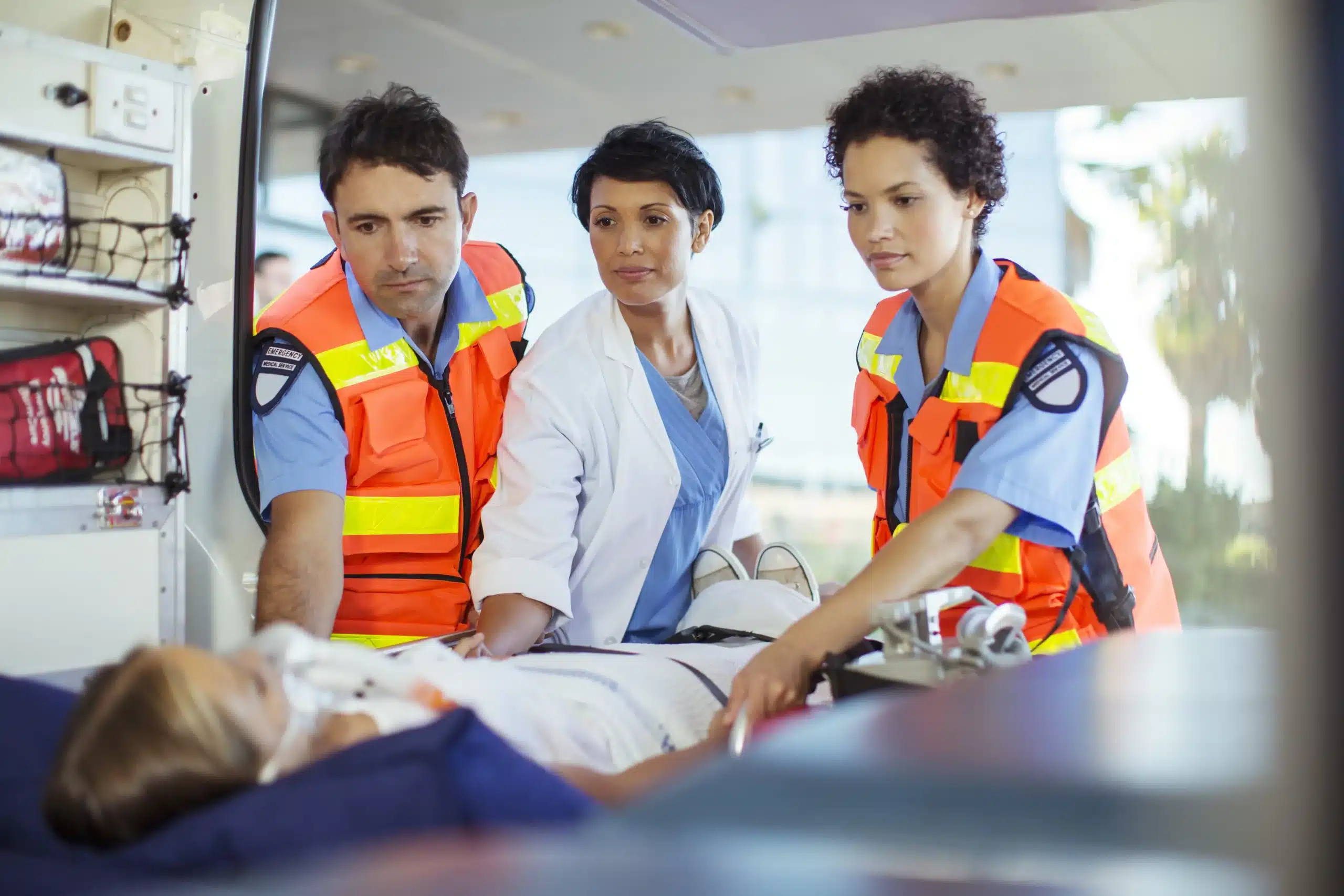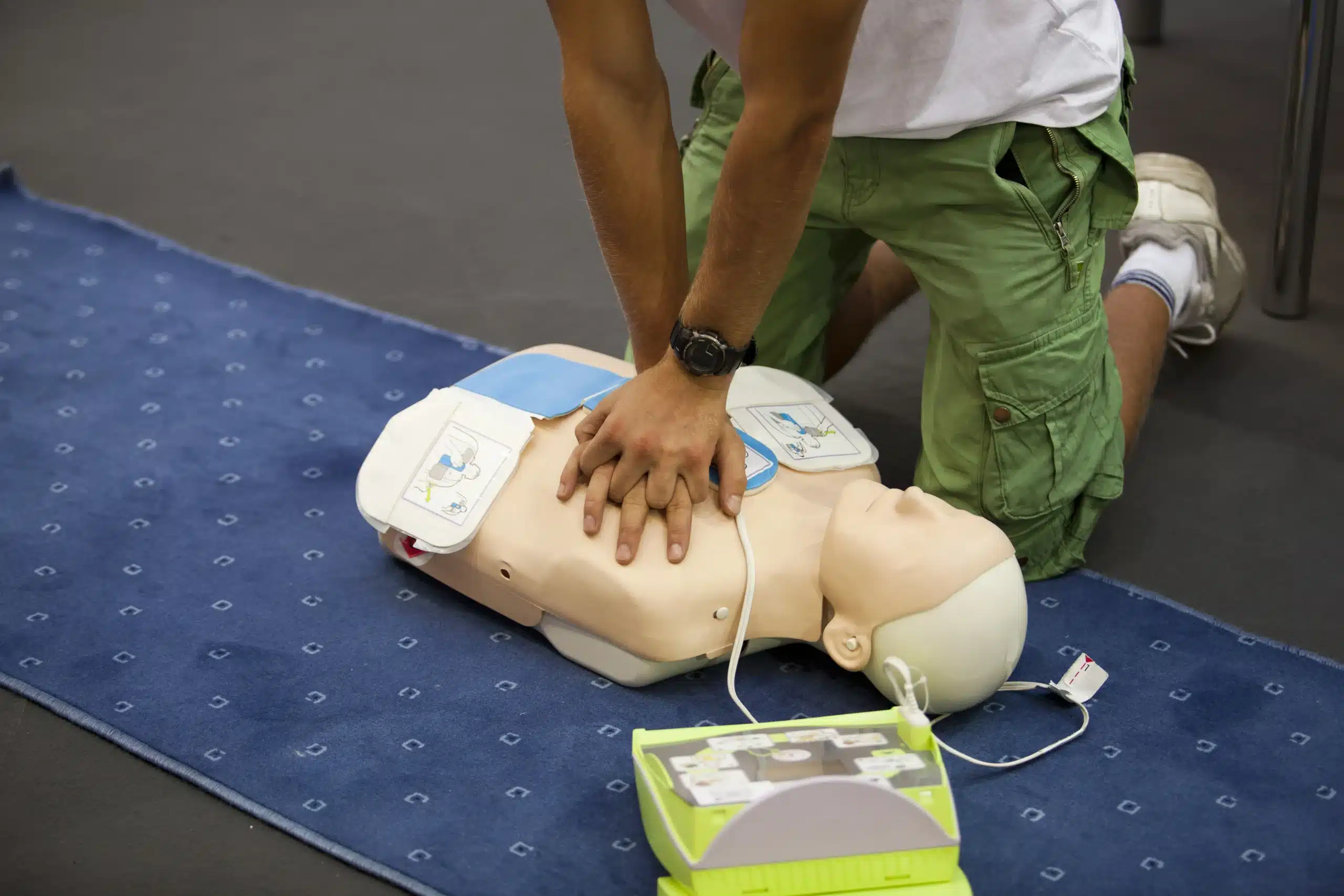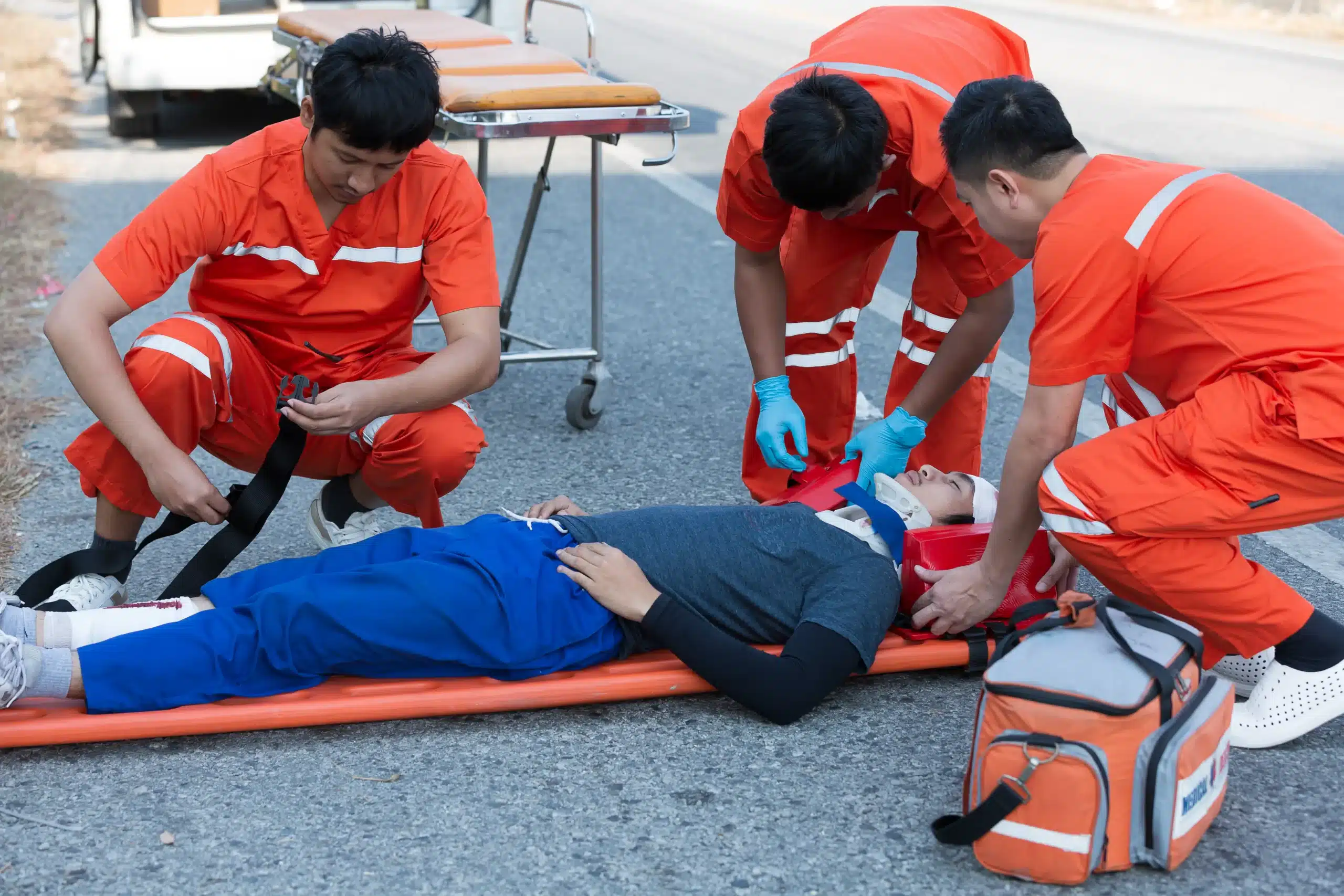In any medical emergency, knowing first aid can be the difference between a positive outcome and a more serious situation. This guide helps you find “first-aid classes near me” and provides a comprehensive overview of first-aid training. We’ll explore various course formats, from traditional in-person classes to flexible online options, and discuss the time commitment involved. We’ll also cover the importance of certifications, how to prepare for your class, and what to expect during the training. Whether you’re a parent, a teacher, a healthcare professional, or simply someone who wants to be prepared, this guide will equip you with the knowledge and resources to choose the right first-aid training program.
Key Takeaways
- First aid skills empower you to handle medical emergencies: From everyday injuries to life-threatening situations, first-aid training gives you the knowledge to respond effectively. Find a course that matches your needs, whether it’s basic first aid, CPR/AED training, or a specialized certification.
- Finding the right course means considering your goals, budget, and learning style: Explore different providers, compare what they teach, and check their certifications. Ask about discounts or if your workplace will sponsor your training.
- Preparing for a first-aid class helps you get the most out of it: Review any pre-course materials, dress comfortably, and be ready to participate actively. The goal is to gain practical skills and the confidence to use them in real situations.
What are First-Aid Classes?
First-aid classes equip you with the skills to handle medical emergencies. From minor injuries like cuts and scrapes to more serious situations, these classes teach you how to provide immediate care before professional help arrives. Different levels of first-aid training cater to various needs and situations. Let’s explore some common types.
Basic First Aid
Basic first-aid courses cover the essentials for handling common injuries and illnesses. You’ll learn how to manage bleeding, sprains, fractures, burns, and choking. These courses also teach you how to assess a situation, prioritize care, and call for emergency medical services. Basic first aid is a valuable skill set for anyone, whether at home, in the workplace, or out in the community. Think of it as a foundational level of knowledge that empowers you to confidently respond to everyday medical incidents. For more comprehensive training, including CPR certification, check out our BLS course.
CPR and AED Training
CPR and AED training focuses on life-saving techniques for cardiac arrest and other breathing emergencies. CPR (cardiopulmonary resuscitation) involves chest compressions and rescue breaths to maintain blood circulation and oxygen flow. AED (automated external defibrillator) training teaches you how to use this device to restore a normal heart rhythm. This combined training addresses critical situations like heart attacks, strokes, and choking. Learning CPR and AED can make a profound difference in survival rates. We offer RQI classes for quick and convenient online certification. Our low price guarantee ensures you’re getting the best value for your training.
Specialized First-Aid Courses
Beyond basic and CPR/AED training, specialized first-aid courses cater to specific environments or situations. These might include wilderness first aid, pediatric first aid, or occupational first aid. These courses delve into the unique challenges and protocols relevant to each context. For example, wilderness first aid addresses injuries and illnesses that can occur in remote locations, while pediatric first aid focuses on the specific needs of infants and children. Choosing a specialized course allows you to tailor your skills to your particular circumstances. If you’re looking for training options in your area, our Northern CA CPR directory can help you find the right fit. We also offer group discounts for businesses and organizations.
Find First-Aid Training Near You
Finding the right first-aid training program involves a bit of research to ensure it meets your needs and location. Here’s how to find a course near you:
Local Options in Dublin, California
If you’re in the Dublin, California area, including Livermore and San Ramon, you have excellent local options. Dublin CPR Classes offers a range of certifications, including BLS, ACLS, PALS, and First Aid. These courses work for both healthcare providers and the general public. For more information on local options, check their page on CPR courses in Dublin. They also offer group discounts, a great option for workplaces or community groups.
National Class Options
Several nationally recognized organizations offer standardized first-aid training courses across the country. These are good options if you need a nationally recognized course.
American Red Cross
The American Red Cross offers a variety of courses, from basic first aid to more advanced certifications. You can easily find a class near you on their website.
American Heart Association
The American Heart Association (AHA) offers widely accepted first-aid and CPR training, often preferred by healthcare professionals. Both Dublin CPR Classes and Safety Training Seminars are AHA Training Centers, offering a range of AHA-certified courses in Dublin.
National Safety Council
The National Safety Council provides first-aid training programs with both online and in-person options, offering flexibility in how you learn.
Check Certifications and Accreditations
Before signing up for a first-aid course, verify the certifications and accreditations of the training provider. Make sure the course meets industry standards and is recognized by relevant organizations. For example, Dublin Training Academy provides certification valid for two years upon successful completion of their Basic First Aid with CPR training.
Read Reviews and Recommendations
Reading reviews and seeking recommendations can offer valuable insights into the quality of different training providers. Look for feedback on the instructors, course content, and overall learning experience. Consider checking online resources like Yelp or Google Reviews. For Dublin-based providers, you can find reviews for companies like First Aid for Everyone.
First-Aid Class Costs & Discounts
Knowing the cost of first-aid training can help you budget and find the best value. This section breaks down average costs, potential discounts, and how to explore workplace sponsorship.
Average Course Costs
First-aid training costs in Dublin, California vary based on several factors. The type of course, the training provider, and the certifications included all play a role in the final price. For example, a basic first-aid course covering common injuries like cuts and burns will typically cost less than a more comprehensive course that also includes CPR and AED training. CPR class prices in Dublin also fluctuate depending on the provider and any bundled certifications. It’s always a good idea to check with several providers, including Dublin CPR Classes, to compare pricing and course content. You can often find this information directly on providers’ websites or by contacting them.
Discounts and Free Resources
Looking to save on first-aid training? Many providers offer discounts, especially for group bookings. Dublin CPR Classes offers group discounts and it’s worth inquiring about similar options for their first-aid courses. Exploring free resources can also supplement your training. While a full certification usually requires a paid course, organizations like the American Red Cross often have free online resources and educational materials. These resources can be a great way to familiarize yourself with basic first-aid principles or refresh your knowledge.
Workplace Sponsorship
Did you know your employer might cover the cost of your first-aid training? Many workplaces will pay for employee CPR/First Aid certification, particularly if it’s a job requirement or beneficial to the company. This can be a great way to gain valuable skills without the out-of-pocket expense. Talk to your HR department or manager to see if your company offers this benefit. Even if your workplace doesn’t fully cover the cost, they may offer partial reimbursement or other incentives. It never hurts to ask!
First-Aid Certifications & Validity
Knowing the different types of first-aid certifications and their validity is key to choosing the right course. Whether you want basic life support training or advanced cardiac care, understanding these aspects ensures your certification meets professional and personal requirements.
Types of Certifications
Several organizations offer first-aid certifications, each with varying levels and specializations. Dublin CPR Classes provides a range of certifications, including BLS, ACLS, PALS, and First Aid, catering to both healthcare providers and the general public. These courses cover essential lifesaving skills, from CPR and AED use to managing medical emergencies and injuries. Other providers, like the American Red Cross and the American Heart Association, also offer similar certifications with nationally recognized standards. You can find more information on CPR courses in Dublin here. Choose a certification that aligns with your goals, whether for personal knowledge, workplace requirements, or professional development. For example, healthcare professionals often require more advanced certifications like ACLS or PALS, while basic first aid and CPR training might be enough for community members or some workplaces.
Validity and Recertification
First-aid certifications are typically valid for a limited time, often two years, as highlighted by the Dublin Training Academy. This ensures certified individuals stay up-to-date with the latest guidelines and techniques. Recertification involves completing a refresher course within the specified timeframe. This process reinforces essential skills and knowledge, maintaining your ability to provide effective first aid. Several institutions, like The Cpl Institute, offer recertification courses to help individuals maintain their qualifications. Regularly updating your certification shows a commitment to providing high-quality first aid and ensures you’re prepared to respond effectively in emergencies. Check with your certifying organization for specific recertification requirements.
What to Expect in a First-Aid Class
Knowing what to expect can ease any pre-class jitters and help you prepare. Here’s a glimpse into a typical first-aid class:
Class Formats
First-aid classes cater to various learning styles and schedules. In-person classes offer a traditional classroom setting with face-to-face instruction and hands-on practice. For those seeking flexibility, online courses, such as those offered by Dublin CPR Classes, allow you to learn at your own pace. These often incorporate blended learning with online modules and in-person skills sessions. This hybrid approach combines the convenience of online learning with the essential hands-on practice required for first-aid skills.
Duration and Time Commitment
The length of a first-aid class depends on the content covered. Basic first-aid and CPR certification can often be completed in a single day. More advanced courses, such as those including CPR for healthcare providers, might require a longer time commitment. Factor in any pre-course reading or online modules if your chosen class uses blended learning. Check with your chosen provider, such as Dublin CPR Classes, for specifics on class duration and scheduling. CPR class costs vary based on the course type and provider, so consider this when making your choice.
Hands-On Practice and Skills Assessments
First-aid classes aren’t just lectures. Expect plenty of hands-on practice. You’ll learn essential skills like CPR, bandaging wounds, and using an automated external defibrillator (AED). Instructors often use mannequins and real-life scenarios to simulate emergencies, giving you a chance to apply your knowledge in a safe environment. Many courses include skills assessments to ensure you’ve mastered the techniques and can confidently respond to emergencies. These assessments might involve demonstrating CPR on a mannequin or correctly bandaging a simulated wound. Successful completion often leads to certification, validating your first-aid skills.
Prepare for Your First-Aid Class
Getting ready for a first-aid class isn’t complicated, but a little prep work can make your learning experience smoother. Here’s how to prepare:
What to Bring
Most first-aid courses don’t require extensive materials. Your instructor will provide any necessary equipment for hands-on practice. Comfortable clothing is a must, as you’ll be moving around and practicing techniques. Bring a notebook and pen to jot down key takeaways and any questions. A water bottle is also a good idea to stay hydrated, especially during longer sessions.
Pre-Course Study Materials
While pre-course study isn’t usually mandatory for basic first-aid classes, familiarizing yourself with basic concepts can be helpful. Explore various providers and course formats to find the best fit for your schedule and learning style. Some organizations, like the American Red Cross and the American Heart Association, offer online resources and pre-course materials you can review. Dublin CPR Classes also offers an RQI program for quick online certification. Even browsing a reputable first-aid website can give you a head start.
Mental and Physical Prep
First-aid training involves learning practical skills and absorbing important information. Being mentally prepared to focus during the class will help you get the most from the experience. A good night’s sleep before the class can make a difference. Since you’ll be actively participating in demonstrations and practice scenarios, make sure you’re physically up for it. Remember, your first-aid certification will be valid for two years, so absorbing as much as possible during the course is key. Knowing you’ll be prepared to assist others in an emergency can also boost your confidence.
Benefits of First-Aid Training
Learning first aid offers significant advantages, from personal growth to career advancement and community impact. Let’s explore some key benefits:
Build Confidence
First-aid training empowers you with the skills and knowledge to handle emergencies effectively. This preparation not only equips you for medical situations but also instills confidence in your ability to respond decisively when needed. Knowing you can make a difference can transform your approach to unexpected incidents, both at home and in public spaces. This newfound confidence can extend to other areas of your life, fostering a greater sense of self-reliance. Check out our basic first aid with CPR training to get started.
Improve Workplace Safety
First-aid training is crucial for workplace safety and often a regulatory requirement. Equipping employees with these skills creates a safer work environment by enabling immediate responses to medical emergencies, potentially minimizing the severity of injuries. A proactive approach to workplace safety demonstrates a commitment to employee well-being and can contribute to a more positive and productive work environment. For businesses in Dublin, California, consider our low price guarantee and explore group discounts we offer.
Contribute to Your Community
First-aid training strengthens your community. Trained individuals can provide immediate assistance during emergencies, potentially saving lives and creating a culture of safety and preparedness. Whether responding to a minor injury at a community event or assisting during a larger incident, your skills can make a tangible difference. Consider adding RQI certification to your skillset; find more information on our RQI classes. Also, explore our Northern CA CPR directory to find additional resources and connect with other trained individuals in your area.
Choose the Right First-Aid Class
So, you’re ready to take a first-aid class—fantastic! Choosing the right course can feel a little overwhelming with so many options. This section will walk you through key considerations to help you find the perfect fit.
Define Your Goals and Requirements
Before you start searching, think about why you want first-aid training. Are you required to get certified for your job, or are you a parent wanting to be prepared for emergencies at home? Knowing your goals will help you narrow down your choices. For example, healthcare providers often need specific certifications like Basic Life Support (BLS), while a general first-aid and CPR course might suit a childcare provider or teacher. Also, consider your schedule and learning style. Do you prefer in-person classes, or would online or blended learning work better for you? Dublin CPR Classes offers flexible options to meet different needs. Think, too, about how the cost fits into your budget.
Compare Course Offerings
Once you have a general idea of what you’re looking for, it’s time to compare specific course offerings. Look at what different providers include in their training. Some courses may focus on adult CPR and first aid, while others might include pediatric first aid or wilderness first aid. Dublin CPR Classes offers a range of certifications, including CPR, BLS, ACLS, PALS, and First Aid, with options for both healthcare providers and the general public. Check if the course covers topics relevant to your needs and if it aligns with any required certifications for your profession. Also, research the instructors’ qualifications. This can give you more confidence in the quality of instruction you’ll receive. Finally, don’t forget to compare prices and look for any available group discounts. Finding a balance between quality instruction and affordability is key.
Top First-Aid Training Providers
Finding the right first-aid training program depends on your specific needs and location. Here are a few reputable providers to consider:
Dublin CPR Classes
If you’re in the Dublin, California area, Dublin CPR Classes offers a range of certifications, including BLS, ACLS, PALS, and First Aid. They cater to both healthcare providers and the general public, with flexible schedules designed for busy lifestyles. Their commitment to low prices and excellent customer service makes them a popular choice. Dublin CPR Classes serves Dublin, Livermore, and San Ramon. Check out their website for more information on CPR courses in Dublin.
American Red Cross
The American Red Cross is a well-known and trusted provider of first-aid training courses nationwide. They offer a comprehensive curriculum covering essential first-aid skills, CPR, and AED use. With numerous training centers, finding a class near you is usually straightforward.
American Heart Association
The American Heart Association is another leading provider of CPR and first-aid training. They offer various courses, from basic life support (BLS) for healthcare providers to first-aid training for the general public. Many organizations recognize and accept AHA certifications.
National Safety Council
The National Safety Council focuses on workplace safety and offers CPR and first-aid training programs designed to meet OSHA requirements. Their courses often emphasize injury prevention and workplace-specific hazards.
St. John Ambulance
While primarily operating internationally, St. John Ambulance offers a variety of first-aid courses tailored to different audiences. They provide everything from basic first aid to advanced training for specific situations. Check their website for courses available in your region.
Related Articles
- First-Aid Training in San Ramon: Your Complete Guide – Dublin CPR Classes
- First Aid Certification Dublin CA: A Practical Guide – Dublin CPR Classes
- Save Lives with Workplace CPR & First-Aid Training
- Why CPR is Crucial in Healthcare
- Group CPR Discount Classes in Dublin – Dublin CPR Classes
Frequently Asked Questions
What’s the difference between basic first aid and CPR?
Basic first aid focuses on treating common injuries like cuts, burns, and sprains, while CPR specifically addresses life-threatening breathing and cardiac emergencies. Both are valuable skills, but CPR focuses on keeping someone alive until professional help arrives.
How do I choose the right first-aid class for me?
Consider your specific needs and goals. If you need certification for work, ensure the course meets those requirements. If you’re a parent, a basic first aid and CPR class might be sufficient. Think about your learning style (in-person vs. online) and your budget. Dublin CPR Classes offers various options to fit different needs.
How long is a typical first-aid certification valid?
Most first-aid certifications are valid for about two years. Check with your specific certifying organization for their exact timeframe. Recertification is usually required to stay current with the latest guidelines.
What if my employer requires first-aid training?
Many employers cover or reimburse the cost of first-aid training, especially if it’s a job requirement. Check with your HR department or manager about your company’s policies.
How can I find first-aid training near me?
Use online search engines, check local community centers, or look into nationally recognized providers like the American Red Cross or American Heart Association. If you’re in the Dublin, California area, Dublin CPR Classes offers a range of courses.


